- How Much Weight Can You Realistically Lose in 3 Months? - January 14, 2024
- How To Lose 1kg a Week (Guaranteed) - August 20, 2023
- How To Count Calories (or Estimate) and Stay on Track When Eating Out at Restaurants - July 25, 2023
You can eat whatever you like and lose, as long as you’re in a calorie deficit, but there are certain foods that will help you stick to your calorie target because they’re filling and satiating. These foods tend to fall into the categories of lean proteins, fruit, vegetables, starchy carbs and low-fat dairy. You’ll be much more likely to adhere to your deficit if you prioritize these types of foods over calorie-dense foods like butter, nuts, peanut butter, chocolate, and mayonnaise.
What is a Calorie Deficit?
Since you landed up here I’m guessing you already know what a calorie deficit is, but let’s recap anyway for those at the back.
A calorie is a unit of measurement related to energy, and every food has a calorie value, based on how much energy it provides.
Vegetables for example have very few calories and provide low amounts of energy. On the other hand, peanut butter has a LOT of calories and therefore provides lots of energy.
In order to lose weight, you need to make sure you’re taking in a little less energy (calories) than you’re using on a daily basis, consistently over a period of weeks and months.
When you’re in this state, it’s called a ‘calorie deficit’ because you’re getting less energy than you need, so your body uses any stored fat you have, to make up for the deficit, and that’s how you lose body fat (and weight).
Now, to clear things up early on, there are no official ‘calorie deficit foods’, you can technically eat whatever you like in a calorie defect and still lose weight.
Yep, you can eat ice cream, doughnuts, Pop Tarts and pizza (exclusively, if you want) and lose weight.
In practice, however, this is a terrible idea.
If you only ate those sorts of calorie-dense, processed foods, you’d use up your calorie budget really quickly (if one slice of Pizza is 250 calories, you’d only be able to eat 5 slices, if you were aiming to eat 1,250 calories per day).
You wouldn’t be getting great nutrition, and you’d probably lack energy.
In short, while losing weight by eating in this way is possible, it’s very difficult, and not advisable in practice.
So, while there aren’t strictly ‘calorie deficit foods’, there are certainly specific foods that will help you stick to a calorie deficit while staying full, and healthy.
Are All Calories Made Equal?
Before we get into the exact foods you should eat in a calorie deficit we need to touch on the ‘is a calorie a calorie?’ debate.
You’ve probably heard tons of people saying that it really doesn’t matter what you eat in a calorie deficit, you can go ‘IIFYM’ and just lose fat eating ice cream, cookies and protein shakes.
On the other end of the spectrum, I’m sure you’ve also heard people preaching the ‘eat clean’ mantra, i.e. that you should only be eating single-ingredient, unprocessed foods to lose weight.
You may have even heard low-carb zealots argue that you need to be careful about spiking your insulin
The fact is, both approaches are way too extreme and the truth lies somewhere in the middle.
While it is true that the bottom line is that if you’re in a calorie deficit, you’ll lose weight, there is one thing that might help you along the way.
And that thing is protein.
Protein is found in;
- Red meat (beef, pork, lamb)
- Poultry (chicken, turkey)
- Fish (cod, salmon, tuna)
- Dairy (yogurt, milk, cheese)
- Eggs
- Protein supplements (whey protein)
(Yes protein is found in other foods like Quinoa, Cous Cous and beans, but the above will be the best, complete sources)
And protein is so helpful when you’re dieting for a few reasons.
Protein helps keep you full
Feeling full is a SUPERPOWER when dieting. You could have the perfect calorie target but if you can’t adhere to it, you won’t get results.
And the key to adhering to a calorie target long term is feeling full and satisfied.
Protein can help keep you full as it takes longer to break down and digest than high carb or high fat foods, so eating more of it when dieting can help you feel full, and adhere to your targets.
Protein helps build and maintain muscle
The more muscle you have, the more calories you’ll burn at rest, and the easier it’ll be to lose weight or maintain your weight.
Additionally, when you do lose weight, the more muscle you have, the better you’ll look. Losing fat and maintaining (or even gaining) muscle will give you a toned, defined look, and who doesn’t want that?!
Eating protein burns calories
This is the #1 coolest thing about protein.
You’ve probably heard the myth that eating Celery burns more calories than it actually contains, and while this isn’t true of protein, it is true that eating protein burns more calories than eating carbs or fat.
This means that the more protein you can get in your diet, the more calories you’ll burn without having to make any effort.
So, the takeaway point is that calories in vs calories out ultimately matters above all else, but you can increase your protein intake to make the process of dieting easier and more effective.
I personally recommend getting around 2g of protein per Kg of bodyweight
WANT IN TO MY FREE 14-DAY FAT LOSS COURSE? PUT YOUR NAME AND EMAIL ADDRESS IN BELOW;
What Foods to Eat in A Calorie Deficit
Ok, here we go I’m going to tell you what foods to eat.
Before I start this section I do want to reinforce the point that you absolutely CAN eat whatever you like and lose weight, provided you’re in a calorie deficit.
Eating the right foods (you could call them calorie-deficit foods, if you wanted to) will make the process so much easier, more sustainable, and mean that you’ll be more likely to stick to your calorie target long-term.
As I mentioned above, the key to sticking to a calorie deficit is staying full and satisfied. The key to doing this is to practice ‘volume eating’, that is, sticking low to low-calorie density foods. These are foods that contain few calories per gram.
‘Calories per gram’ is an important factor to consider when dieting (most people overlook this) because it gives you a rough idea of not only how many calories are in what you’re eating, but how filling that food could be.
If you take something like Lettuce as an example; a typical ‘diet food’, and with good reason. Lettuce has just 0.15 calories per gram, this means that you could eat 500g of Lettuce and only take in 75 calories.
500g is a LOT of food, and would certainly fill you up to a degree because you’d be taking up so much room in your gut.
Let’s compare that to Peanuts for example. Now you’ll probably hear a lot of people recommending nuts as a good diet food; they’re rich in healthy fats, protein and fiber. Great. But I’ll tell you something else they’re rich in…
Calories.
In fact, peanuts contain around 6 calories per gram. If you were to eat the same 500g of peanuts, you be taking up less space in your gut (500g of peanuts have a lot less volume than 500g of lettuce), but crucially taking in 3000 calories!
And THAT is why ‘calories per gram’ and food volume matters. On the chart below you can see the calories gram for some other common foods.
| FOOD | CALORIE DENSITY (KCAL/G) |
| Lettuce | 0.15 |
| Spinach | 0.23 |
| Watermelon | 0.3 |
| Strawberry | 0.32 |
| Carrot | 0.4 |
| Orange | 0.48 |
| 2% Fat Milk | 0.5 |
| Apple | 0.52 |
| Grapes | 0.69 |
| Boiled Potato | 0.87 |
| Banana | 0.89 |
| Ketchup | 1 |
| Chicken Breast (No Skin) | 1.1 |
| Brown Rice | 1.1 |
| White Fish (Tilapia) | 1.13 |
| Tuna | 1.16 |
| White Rice | 1.3 |
| Pasta (Spaghetti) | 1.31 |
| Pork Loin | 1.36 |
| Quiona | 1.43 |
| Salmon | 1.45 |
| Egg | 1.48 |
| Avocado | 1.6 |
| Whole Wheat Bread | 2.48 |
| Steak | 2.5 |
| White Bread | 2.64 |
| Burger Patty | 2.82 |
| Mozarella | 3 |
| Raisins | 3 |
| Fries | 3.07 |
| Black Beans | 3.41 |
| Frosties | 3.67 |
| Mayonaise | 3.86 |
| Nutella | 5.41 |
| Peanuts | 6 |
| Butter | 7.21 |
| Olive Oil | 8.85 |
Of course, we kind of know a lot of this already.
Yes, fruit and vegetables are great to eat when dieting, and we should be avoiding stuff like butter and Nutella, but there are a few surprises in there as well. Yes, Salmon and Olive Oil might be ‘healthy’ but should you eat a lot of either when dieting? Probably not.
Similarly, most people would class stuff like potatoes and Ketchup as not ideal diet or ‘calorie deficit’ foods, but potatoes stack up very well against other carbs, and Ketchup has a much lower ‘calorie per gram rating than Mayo and other cream-based sauces.
What I’m certainly not saying is only eat foods on the upper half of that list, indeed that list only contains a very small sample of foods. When you’re dieting, you still need a mix of protein, carbs and fats to allow for optimal health and good performance in the gym.
One other thing to consider is that zero-calorie foods do exist; for example, Diet Coke is calorie-free, and there are products like zero-calorie noodles and zero-calorie jelly. These kinds of foods are obviously really good for keeping you in a calorie deficit, just be mindful that you do actually need calories for energy and optimal health!
So what are my recommendations for the best foods to eat on a calorie deficit?
- Chicken Breast
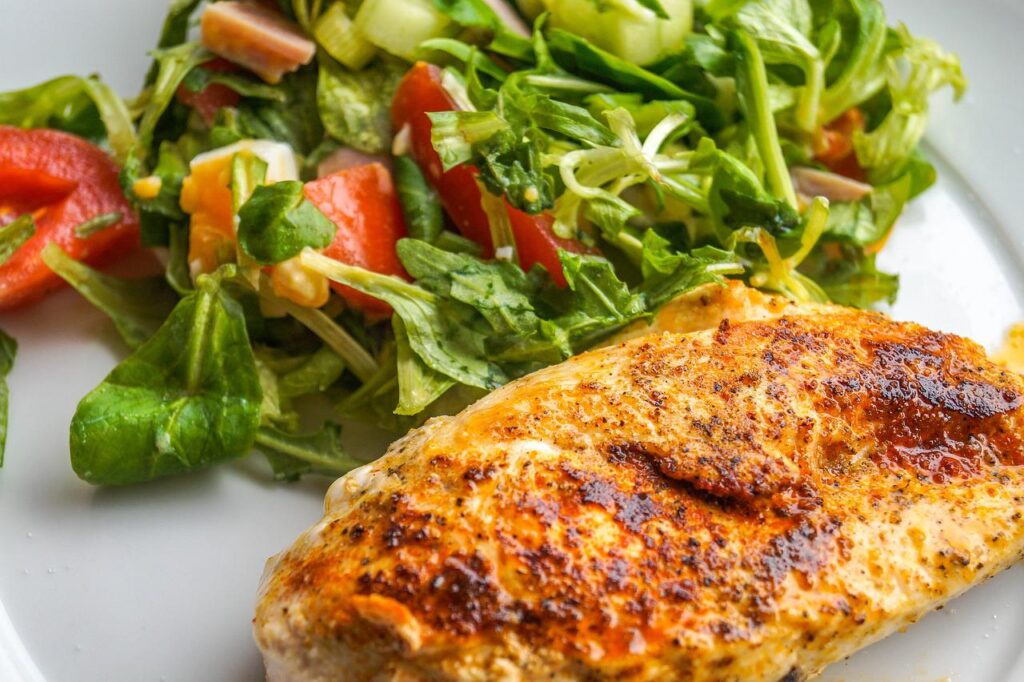
Chicken breast is widely available, versatile and fairly affordable if you get it from the right place. It goes with almost anything, is great at lunch or dinner and there are tons of chicken breast recipes out there.
Make sure you get chicken breasts without skin, because skin drastically increases the fat and therefore, the calorie content.
When you cook your chicken, don’t deep fry it or cover it in cooking oil, since this will also drastically increase the calorie content, use Fry Light 1 calorie spray and grill it to get a nice char on the outside before putting in the oven to cook it through while keeping it moist.
- Broccoli
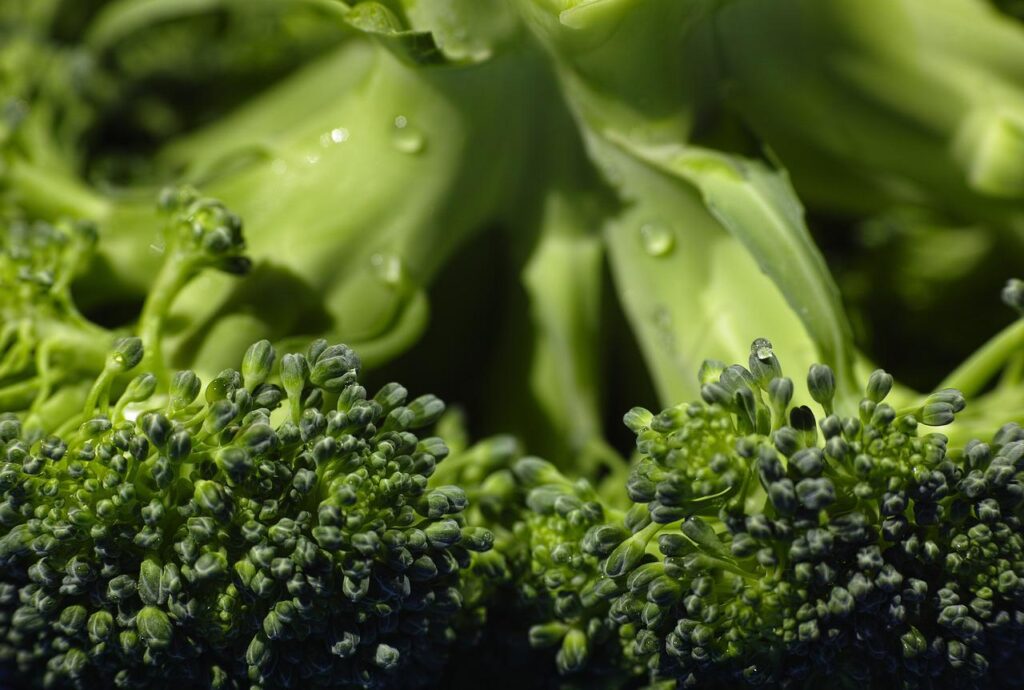
Broccoli is my go-to veg. Ok, it’s difficult to stake the claim that any green veg tastes ‘amazing’, but Broccoli definitely has a lot of potential.
My favourite way to prep is to buy Tenderstem and grill it (and, with Fry Light) in a pan with some good salt, chili and garlic.
- Potato
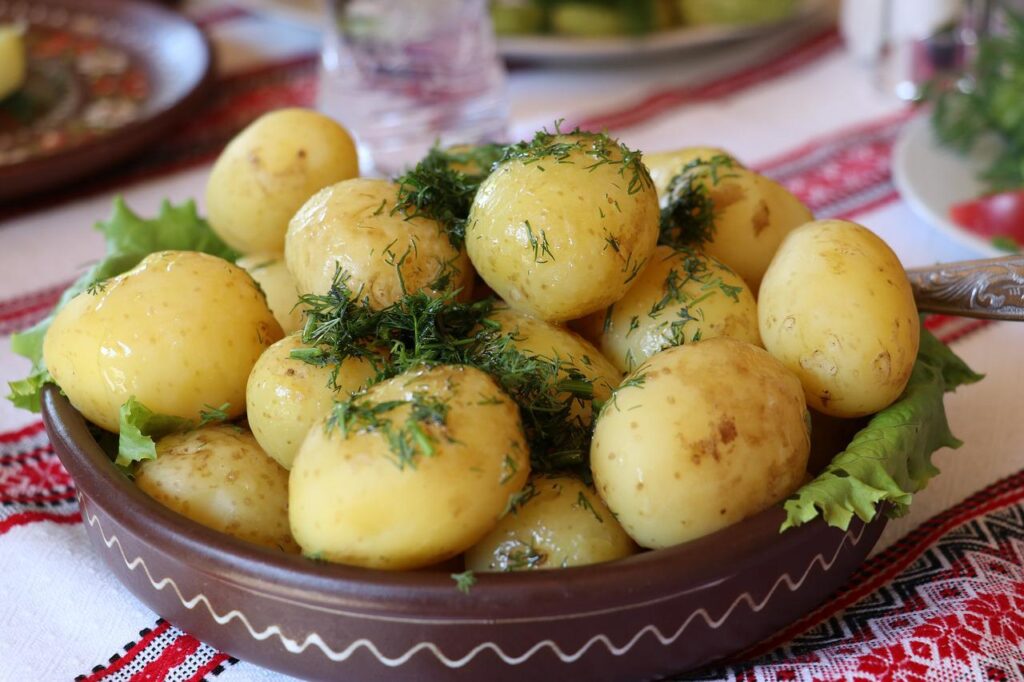
As I mentioned above, potato is a massively underrated diet food.
Potato is wrongly demonized, and this is probably because people generally consider chips (or fries for our US friends) to be ‘bad’ food, especially if you want to lose weight.
Chips certainly can be high in calories, especially if they’re deep-fried in oil and thinly cut (because they’ll absorb more oil), but this shouldn’t reflect badly on the potato itself.
Potato is highly satiating and a lot less calorie-dense than other carbs like rice, pasta and bread. If you want to incorporate them into your diet, then be sure not to add too much fat. Boiled or baked potatoes are the way to go – my personal favourite filling is sour cream, black pepper and chives
- Greek 0% Yogurt
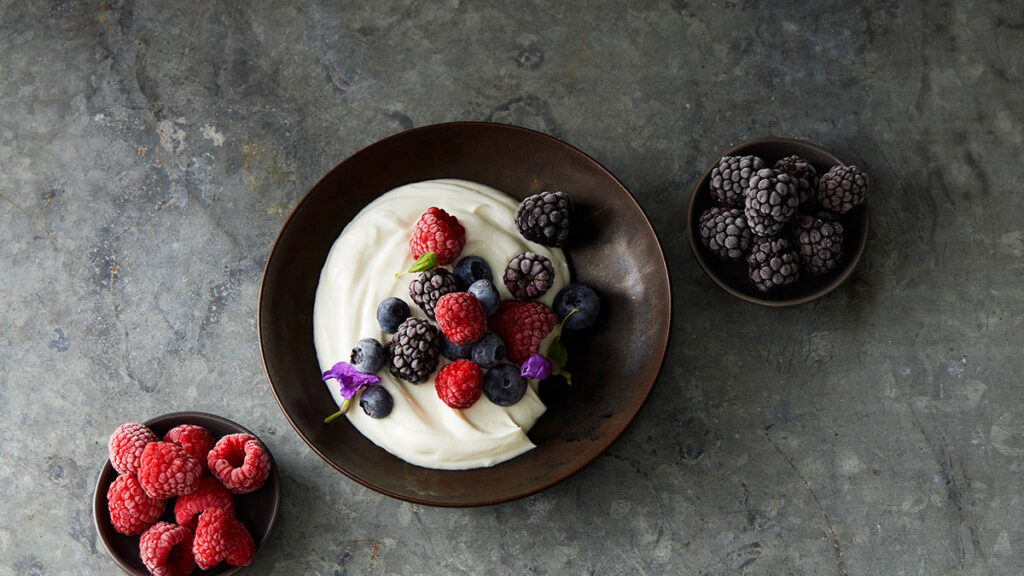
This really is a powerhouse diet food and an absolute staple in my everyday diet.
Now there are lots of different brands of Greek Yogurt and they all have slightly different Macros and Calories, and I don’t know all of them off the top of my head, my favourite is Fage, hands down.
They make 0%, 2% and 5% Greek Yogurt but I’d always go for the 0%. It’s incredibly low in calories, high in protein and filling, and you can’t ask for much more than that.
But the best thing about this stuff is that it’s so versatile. You can have it for breakfast with some berries and honey, and it works as a filling for wraps and baked potatoes.
- Egg Whites

Egg whites are the definition of a low-calorie, high protein food.
If you didn’t know, Yolks are made up almost entirely of fat, and whites are almost totally of protein, which is why the whites are lower in calories than Yolks (and therefore whole eggs).
Am I saying don’t eat whole eggs? No.
What I am saying is, if you normally use 4 eggs for an Omelette, maybe use one whole egg and 3 egg whites. It won’t taste that different and it’ll be significantly lower in calories.
6. Protein Powder
This may be controversial since some people don’t really consider whey protein to be a ‘food’ but rather a supplement.
For me, it falls firmly into the ‘food’ category since it’s something that could be consumed daily without any issues, and it is essentially just powdered milk.
The best protein powders typically contain around 100 calories and around 20g of protein per serving, making them a low-calorie, convenient snack and a great. cheap source of protein. The only hard bit is picking your favorite flavour!
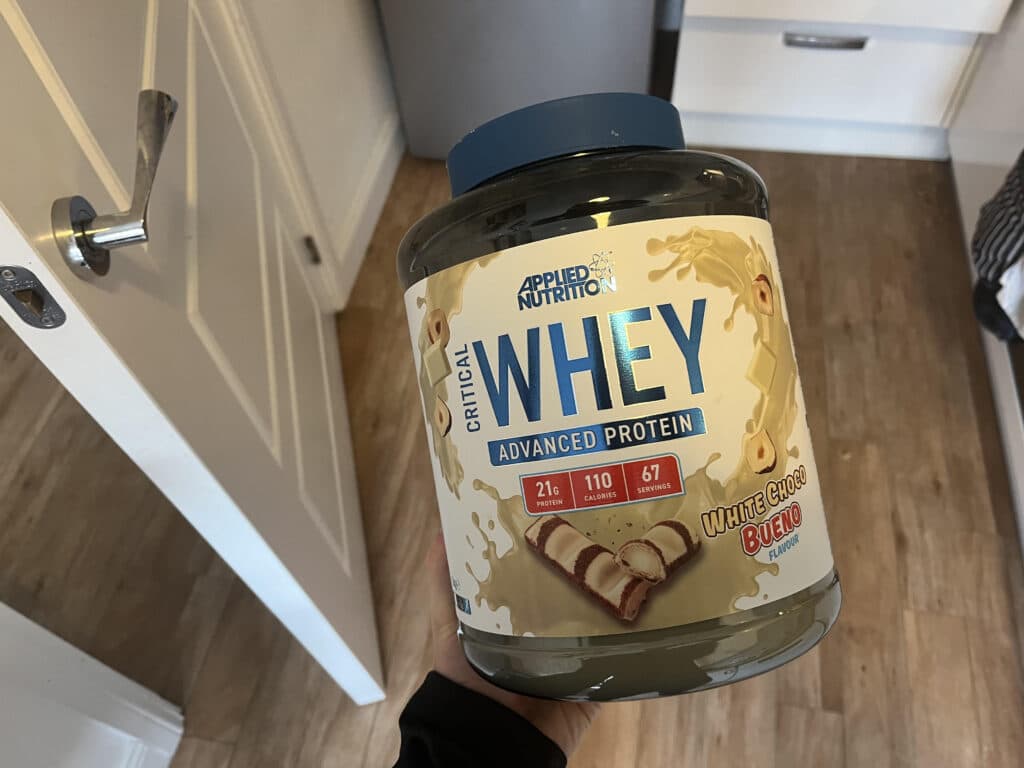
7. White Fish
There are tons of white fish to choose from; Cod Haddock and Hake are the well-know and much moved favourites, but if you want to more exotic, tropical fish like Swordfish or Red Snapper offer a totally different taste and texture. Whatever you go for, white fish is generall extremely low in fat and therefore calories, it’s also very high in protein. A 250g portion of Cod for example clocks in at just 300 calories and 50g of protein which is great bang for your nutitional buck. Just remember to flavour with calorie free seasons and garnish like lemon and pepper, and don’t drench in oil as this will dramatically increase the calories.
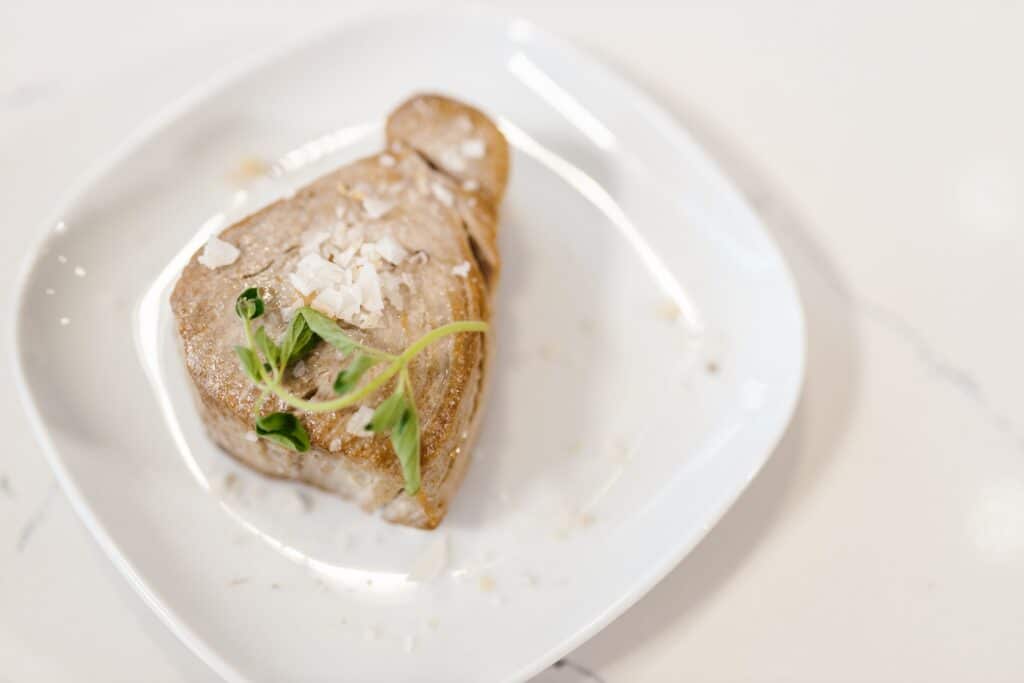
8. Skimmed Milk
There are tons of different varieties of milk out there from the full fat, creay gold top to the ultra lean red-top skimmed milk. Skimmed milk is far more watery, less creamy and less flavoursome than higher-fat varities of milk; but it only packs 70 calories for a 200ml glass, and has a fat content of around 2%. Its; also just as filling and high in protein as its full-fat counterpart.

9. Low-Fat Cheese
Cheese makes for a great tasty snack, but breaking off endless chunks of cheddar from the fridge is a recipe for diaster if you’re dieting. Instead opt for lower-calorie low fat cheeses like Babybel Light (Edam Cheese), these come in at just 50 calories and have 5g of protein

10. Bananas
Ok, Bananas might not be the lowest calorie fruit out there, but they still only pack around 100 calories per medium-sized banana which isn’t bad at all when you consoder that the fast releasing fructose sugars will give you enough energy to push through a moderte workout
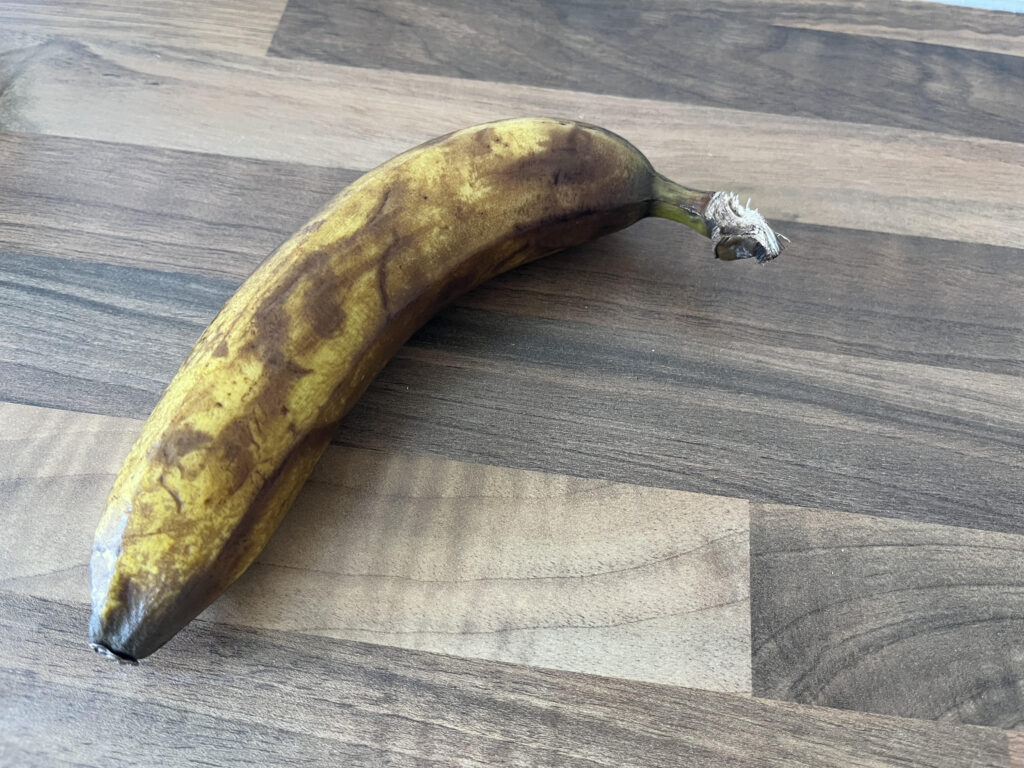
What Foods to Avoid On a Calorie Deficit
Knowing what not to eat is just as important as knowing what to eat on a calorie deficit. And to reiterate, you don’t need to totally avoid any of these foods, but you would do well to limit them.
- Peanut Butter
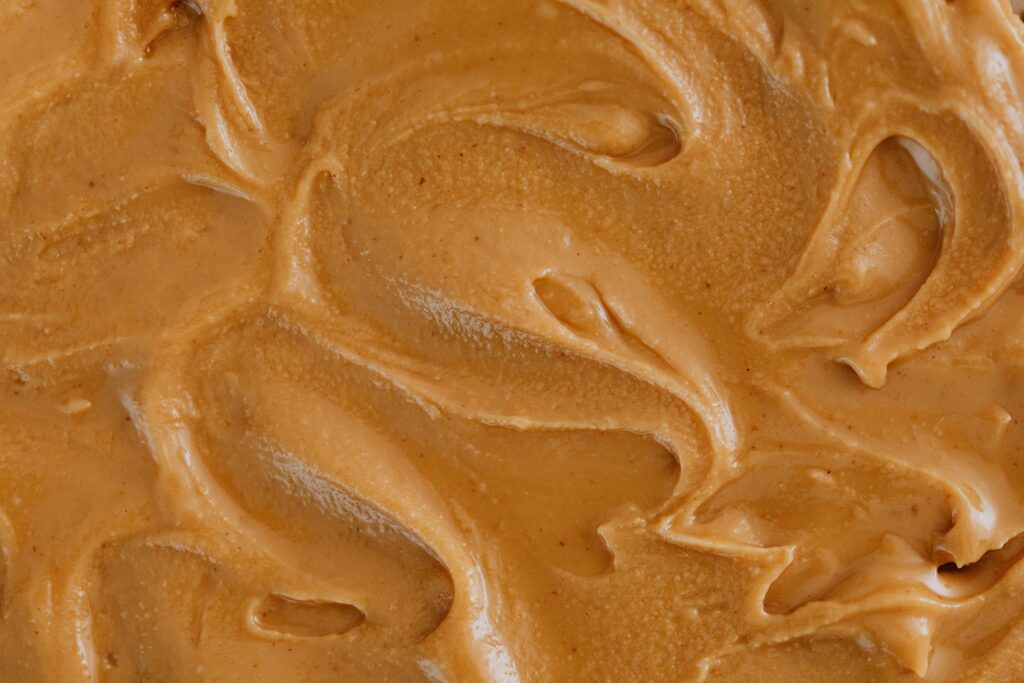
Peanut butter is what’s known as ‘hyper-palatable’’ food. It contains a mixture of salt, fat and sugar making it delicious, easy to eat, and addictive.
I don’t know about you, but I can eat this stuff right out the jar, and before you know it, you’ve made your way through hundreds of calories without even noticing.
What’s crazy is that a lot of people seem to think PB is ‘high in protein’ or great for dieting. It’s neither of those things. I’d say you’d be best off just not having this in the cupboard when you’re dieting.
- Oil
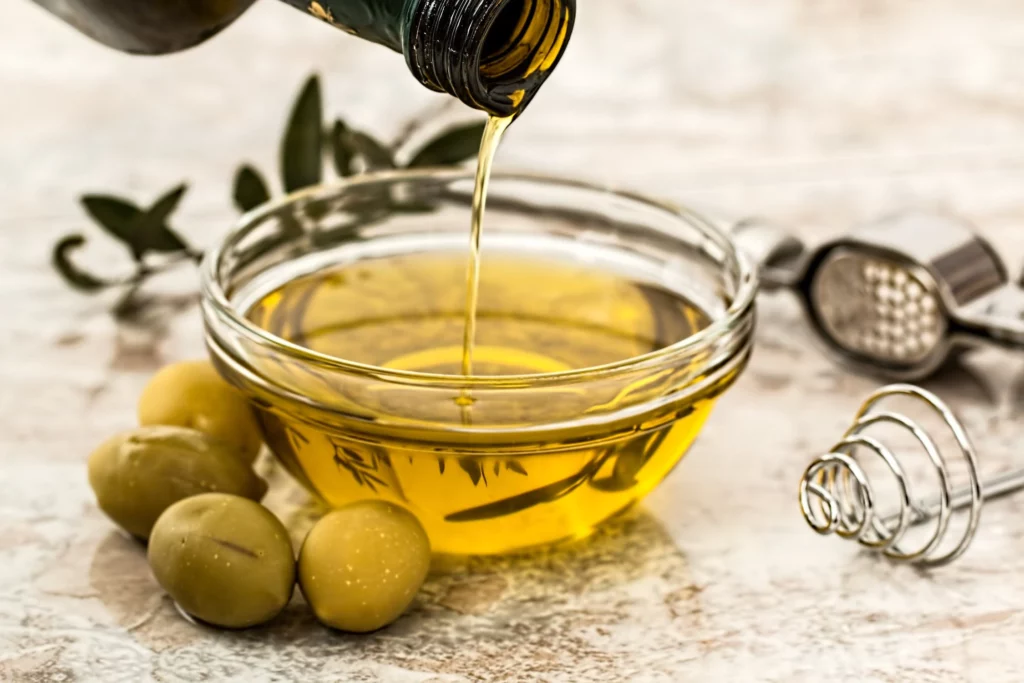
The number one tip I’ll give everyone that starts with me is to ditch the cooking oil. Cooking oil is essentially liquid fat and is incredibly calorie-dense.
While cooking oil can mean your food is less likely to stick to the pan, it doesn’t enhance the texture or flavour of your food, and it can add HUNDREDS of calories.
Just swap cooking oil for Fry Light. It’s a no-brainer.
- Butter
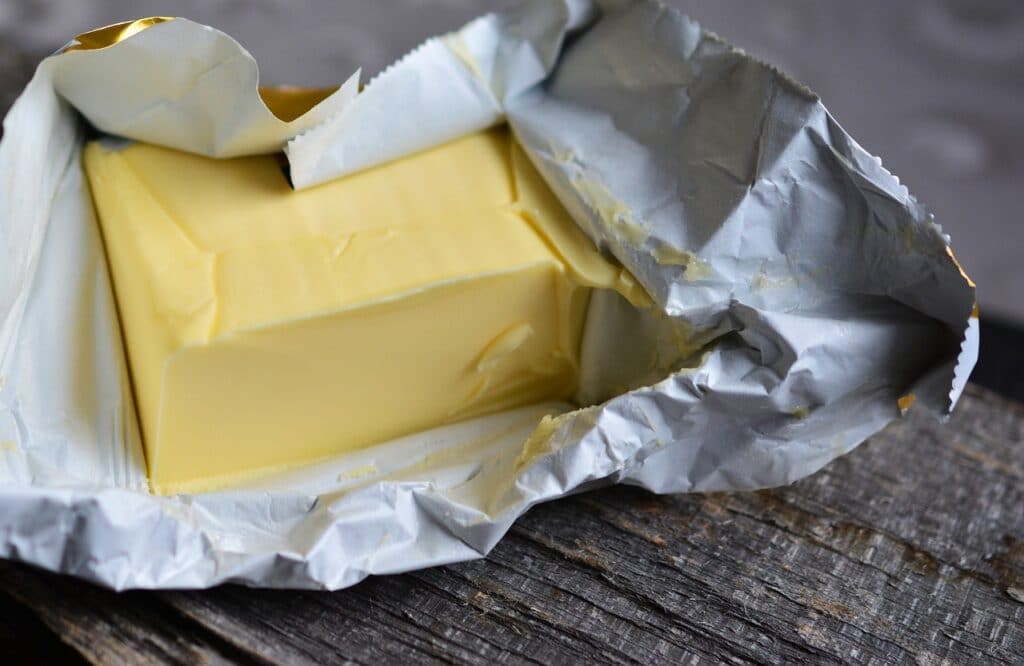
Butter is another food that’s basically pure fat, and wherever there’s fat, there are calories.
Yes, toast and butter is great, but you need to make some sacrifice when you’re dieting, and butter should probably be one of them.
Luckily there are some low fat and low-calorie alternatives like Margarine.
- Cheese

Cheese is another highly addictive, high-fat food.
If you’re dieting, I’d severely limit the amount of Cheddar, Brie and Gruyere you have, but the good news is that there are loads of lower-fat cheese out there like;
- Edam
- Cottage Cheese
- Mozerella
- Ricotta
This means you can still fuel your cheese addiction while you’re dieting. There are even low fat and low-calorie versions of Cheddar available now from a UK company called Eat Lean
- Chocolate
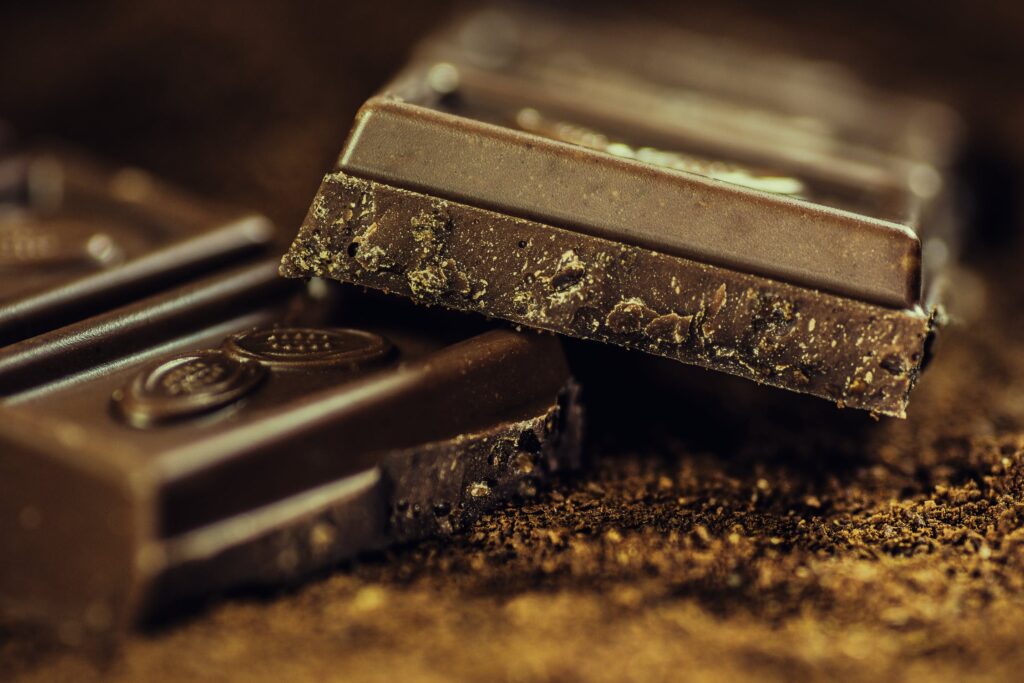
I saved the best until last didn’t I?
Who doesn’t love chocolate in some form? I certainly do but having vast quantities in the cupboard (or fridge – that debate won’t die will it?) is not going to help you if you’re dieting. No one with easy access to chocolate is going to have an easy time being a calorie deficit.
My advice? If you’re going to have chocolate in the house, buy dark chocolate (60% cocoa or over), this has an intense chocolate taste, so you’ll only need a small amount to satisfy your craving.
Even better, have no chocolate in the house, and have a rule that if you want chocolate, you need to go the nearest shop and buy it. This puts a barrier between you and the chocolate that will mean you eat at least eat a lot less than you would if it was waiting for you in the kitchen…
6. Nuts
Another controversial one here; and while it’s true that nuts are packed with fiber, good nutrients and some protein, many of them are also incredibly high in calories.
This is because nuts contain a lot of fat, which of course means lots of calories. Nuts are typically touted as a healthy food, which is true, but that doesn’t mean they’re the best for dieting!
One Brazil Nut for example can contain over 100 calories! Nuts can also be really tasty, especially if they’re covered in salt or flavourings.
If you love nuts, moderation is the key word!
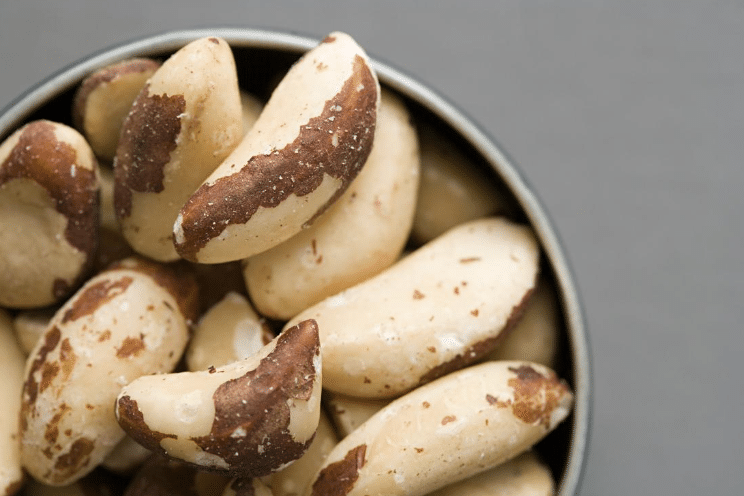
The 80/20 Rule
Although I’ve just told you to avoid all the foods above, you don’t need to totally avoid them, but you do need to limit them.
But how often can you have them?
Well, I like to live by the 80/20 rule, and in this context, that means 80% low calorie-dense, nutrient-dense foods, and 20% higher calorie-density foods.
For me and my clients, this is a much better way to operate than the classic ‘eat clean for 5 days a week then have cheat days at the weekend’
If you do this, you deprive yourself for such a long period of time (yes, five days is a long time to go without food you love) that by the time you get to the weekend, you’ll binge so hard at you’ll go over your calorie target.
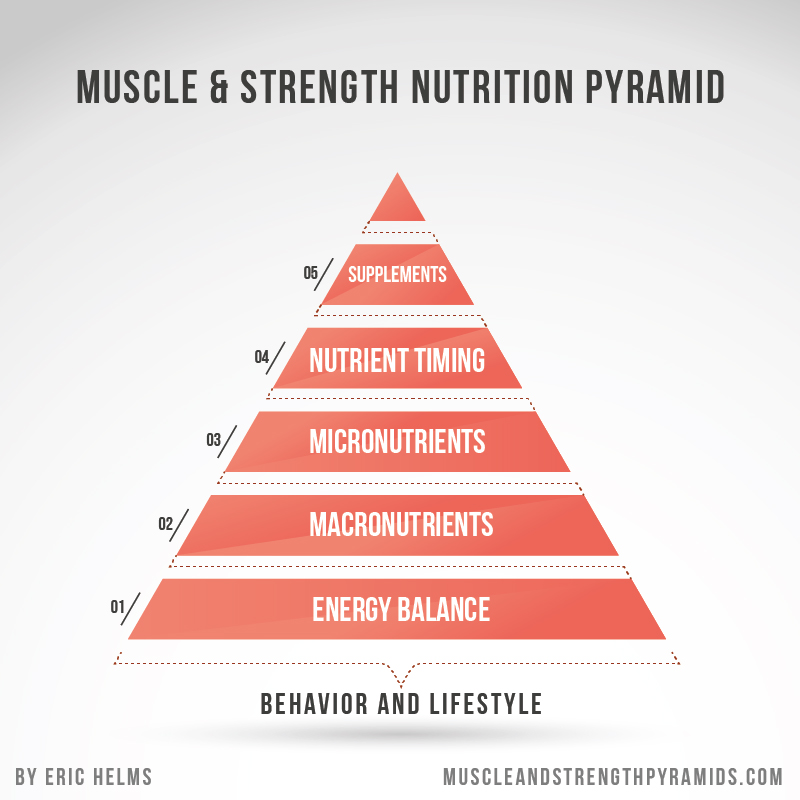
For example, let’s say you’re aiming to eat 2,000 calories per day on average over the course of a week.
You stick to 1,800 calories per day from Mon-Fri which would leave you with an extra 1,000 calories to play with at the weekend.
This means you can have 3,000 calories on Saturday. But you overshoot and end up eating 3,600. You know you screwed up so you think f**k it, and overeat on Sunday as well.
| MON | TUE | WED | THU | FRI | SAT | SUN |
| 1,800 | 1,800 | 1,800 | 1,800 | 1,800 | 3,600 | 2,300 |
What is means is, rather than your average calorie intake for the week being 2,000 per day, it’s actually 2,129 per day.
Although this might seem insignificant, it could be just enough to stop you from losing weight, and make you think that ‘diets don’t work’, and force you to slip into a yo-yo dieting cycle.
The solution, utilize the 80/20 rule to ensure you’re eating at least some of what you love every day.
Let’s say for example that you love Chocolate and Full Sugar Coke. Rather than completely driving yourself of these things, you could have a little each day.
To illustrate the 8/20, I’ve come up with what a typical ‘full day of eating’ might look like for an average person. We’ve got yoghurt and granola for breakfast, soup with bread for lunch and a sweet and sour chicken stir fry for dinner, all of which is generally high volume, healthy whole food. We’ve also got a cheeky handful of gummi bears and a couple of spoons of PB in there which we might consider ‘calorie dense’.
| FOOD | AMOUNT | CALORIES |
| Greek Yogurt | 250g | 125 |
| Banana | 1 | 100 |
| Granola | 50 | 180 |
| Soup | 1 can | 200 |
| Bread | 2 x slices | 200 |
| Apple | 1 | 100 |
| Chicken | 200g | 330 |
| Mixed Veg | 100g | 50 |
| Noodles | 150g | 235 |
| Sweet and Sour Sauce | 125g | 85 |
| Gummi Bears | 20 | 200 |
| Peanut Butter | 50 | 290 |
| TOTAL | 2,095 |
Total calorie intake for the day is 2,095 calories, which is about right for a 100kg (220lb) person to lose weight. 490 of those calories are made up of ‘calorie-dense’, less healthy foods (the gummi bears and PB), which means that 23% of the calories have come from those types of foods, and 77% from more healthy, high volume foods, almost spot on!
Example Meals
It’s all very well knowing what individual foods to eat but in the real world, you’re not going eat a chicken breast with greek yogurt and a side of egg whites.
So how do you incorporate these foods into actual meals that you’d eat every day? Of course, there are endless combinations of meals you can make with stuff like chicken, eggs and yoghurt, but I’ve given you a few examples below, along with ingredients.
All of these meals are high in protein, low calorie, healthy and super filling.
Sausage and Shrimp Skillet
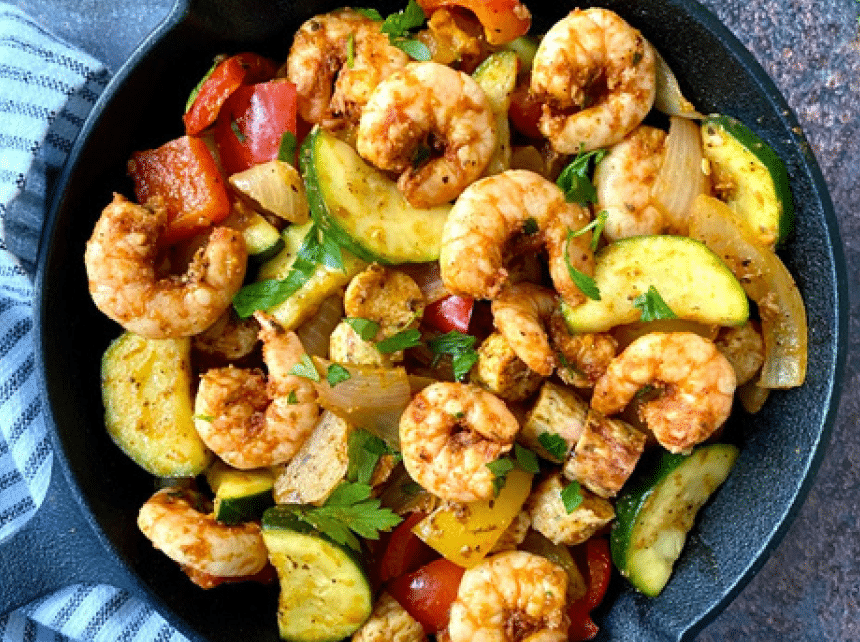
Ingredients
packet low-fat chicken
sausages (eg Heck), sliced
into rounds
250g cooked, peeled
prawns
15ml olive oil
1 onion
500g zucchini, cut into
quarters
1 red bell pepper
1 yellow bell pepper
4 garlic cloves, minced
2 tbsp tomato paste/puree
1 tbsp cajun seasoning
1 tsp smoked paprika
1 tsp cayenne pepper
(optional)
Salt and pepper to taste
Fresh parsley to garnish
Method
- Heat the oil in a deep skillet or pan on a medium-high heat. Add the sausage and cook until brown.
2. Add the onion and saut for a few minutes, until soft. Add the bell peppers and garlic to the pan, along with the tomato paste, salt, pepper, cajun seasoning, paprika and cayenne. Stir thoroughly.
3. Once the peppers have started to soften, add in the zucchini and cook for a further 2-3 minutes.
4. Lastly, add in the cooked prawns and combine with the rest of the ingredients. Serve with rice, potatoes or your choice of carbs.
Greek Chicken Bowl
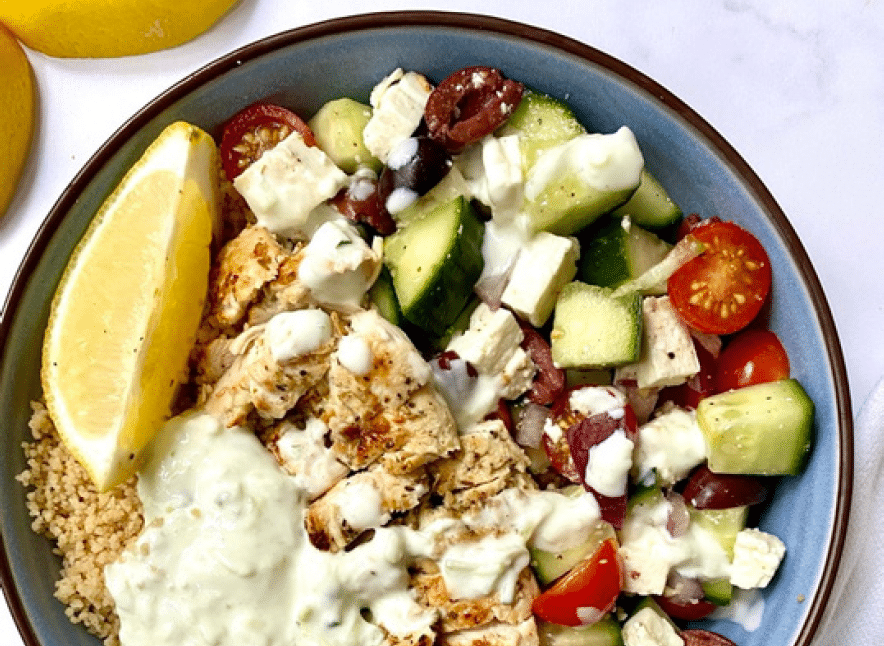
Ingredients
500g boneless, skinless
chicken breast
15ml olive oil
15ml lemon juice
4 garlic cloves, finely minced
200g wholewheat couscous
300ml boiling water
1 red onion
1 cucumber, cut into quarters
100g cherry tomatoes, halved
80g light feta, cubed
80g kalamata olives, halved
1 tsp dried oregano
1 tsp dried thyme
Salt and pepper to taste
For the tzatziki
250g low-fat, plain Greek
yoghurt
100g cucumber, grated
2 garlic cloves, finely minced
1 tbsp lemon juice
1 tbsp fresh mint, finely
chopped
5ml olive oil
Salt to taste
Method
- In a large bowl mix together the olive oil, lemon juice, salt, pepper, minced garlic, thyme and oregano. Add in the chicken breast and coat well. Leave to marinate for at least 20 minutes.
- When ready to cook, heat a non-stick pan or griddle on a high heat. Place the chicken breast in the pan and cook for 8-10 minutes on each side, or until the chicken is cooked through completely.
3. For baked chicken breast, preheat the oven to180 C/ Gas mark 6 and bake for 20-25 minutes, or until cooked through.
4. In the meantime, place the couscous in a large bowl and pour over the boiling water. Cover and leave for 8-10 minutes then break up gently with a fork.
5. In another large bowl, mix together the cucumber, cherry tomatoes, red onion, feta and olives. Season with salt and pepper and set aside.
6. To make the tzatziki, mix together all the ingredients in a medium sized bowl. Once the chicken is done assemble the bowls with a portion of chicken, couscous and salad. Add a dollop of tzatziki and enjoy!
Chilli Con Carne
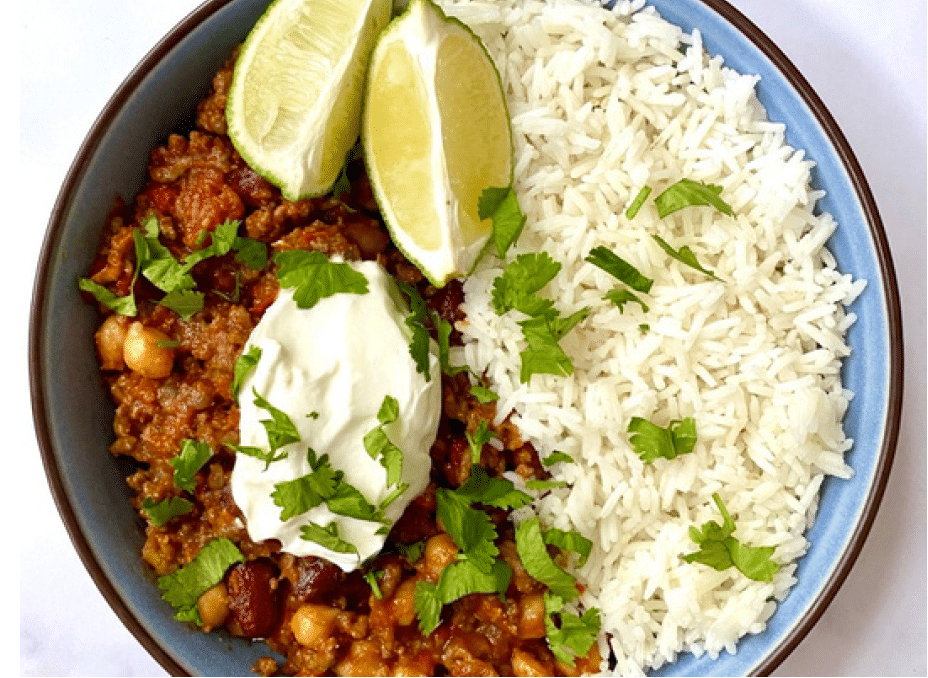
Ingredients
500g lean beef mince or
vegetarian mince
1 tin chickpeas, drained
1 tin kidney beans, drained
1 400g tin chopped
tomatoes
1 bell pepper
1 large onion, chopped
15ml oil of choice
2-3 chillies
6 garlic cloves, crushed
30ml tomato pur e/paste
3 tsp smoked paprika
4 tsp cumin powder
2 tsp oregano
1-2 tsp chilli powder
Salt to taste
Freshly chopped coriander
to garnish
Method
- Heat the oil in a large skillet and add in the onion, peppers and chillies. Saute for a few minutes until soft.
2. Turn the heat up to high and add in the garlic, spices and the mince. Allow the mince to brown, breaking it up as it cooks.
3. Add the chopped tomatoes and tomato puree and bring to a simmer. Turn the heat down, cover with a lid and leave to simmer for about 30 minutes, stirring occasionally.
4. Add in the chickpeas and kidney beans and cook for a further 10-15 minutes.
5. Serve with rice or tortillas and top with cheese, sour cream, avocado and coriander.
FAQs
What foods help to burn belly fat?
There is no single food that can specifically target belly fat. In order to lose fat, you need to create a calorie deficit (eat fewer calories than you use on a daily basis over a long period of time). However, certain foods may be helpful in helping you achieve that calorie deficit, and consequently reducing belly fat.
Here are some examples of foods that may be helpful in reducing belly fat:
Berries: Berries, such as strawberries, raspberries, and blueberries, are high in fiber and very low in calories
Green leafy vegetables: Vegetables, such as spinach, kale, and broccoli, are high in fiber, very nutrient dense and low in calories, which can help reduce belly fat.
Lean protein: Protein, such as chicken, turkey, white fish, low-fat dairy and tofu, can help keep you full and also build muscle and boost metabolism.
Potatoes: Potatoes have been shown to be incredibly satiating (filling) and are relatively in calories. Obviously, this is only true if you don’t add high calories fillings like cheese, butter and coleslaw.
It is important to note that reducing belly fat requires a combination of a healthy diet, regular physical activity, sufficient sleep, and most importantly, a calorie deficit. There is no single food or magic solution for reducing belly fat.
What should I avoid when trying to lose weight?
Here are some things to avoid when trying to lose weight:
- Processed foods: Processed foods, such as chips, cookies, and frozen meals, are often high in added sugars, unhealthy fats, and calories, and may contribute to weight gain.
- Sugary drinks: Beverages like soda, fruit juices, and sweetened coffee and tea are high in added sugars and calories and can contribute to weight gain.
- High-fat foods: Foods that are high in saturated and trans fats, such as fried foods, fast food, and processed meats, may contribute to weight gain and should be limited.
- Alcohol: Alcoholic beverages are high in calories and can contribute to weight gain. It is important to limit alcohol intake or choose lower-calorie options when trying to lose weight.
It is important to note that these foods CAN be eaten while trying to lose weight; as long as you’re in a calorie deficit weight loss WILL happen. Eating these foods on a regular basis however likely WILL make weight loss a lot more difficult.
What fruit is best for weight loss?
There is no single “best” fruit for weight loss. However, some fruits may be more beneficial for weight loss than others due to their fiber and nutrient content.
Here are some examples of fruits that may be helpful for weight loss:
- Berries: Berries, such as strawberries, raspberries, and blueberries, are high in fiber and low in calories.
- Apples: Apples are high in fiber and have a low energy density, which may help with weight loss.
- Oranges: Oranges are high in fiber as long as you eat the whole fruit, rather than just the juice.
- Grapefruit: Grapefruit is high in fiber and has a low energy density, which may help with weight loss.
Fruit is not a magic weight loss solution however, you can still eat fruit and gain weight. You need to be in a calorie deficit for weight loss to occur
What foods don’t put on weight?
The only foods which technically won’t contribute to weight gain a zero calories foods (or foods that are VERY low in calories). Some examples of zero calorie foods are below;
- Zero Calorie Syrups
- Coke Zero/Diet Coke
- Zero Calorie Jelly
- Zero Calorie Noodles
- Tobasco Sauce
- Black Coffee
- Black Tea
- All Herbs and Spices
- Fry Light Spray
- Garlic
It is important to remember however that you do need calories to function and be healthy, you should NOT try to avoid calories altogether.
Are eggs good for weight loss?
Eggs can be a part of a healthy diet for weight loss. They are a good source of protein, which can help with weight loss by helping to build muscle and boost metabolism. Eggs are also low in calories, with about 70-80 calories per egg, and are versatile, making them easy to incorporate into a variety of meals.
That being said, it is important to keep in mind that weight loss requires a calorie deficit, which means that the number of calories burned must be greater than the number of calories consumed. While eggs can be a part of a healthy diet for weight loss, it is important to focus on the overall balance of calories and nutrients in your diet, rather than on any single food.
Summary
Yes, you CAN eat whatever you want and lose weight as long as you’re in a calorie deficit, but the process will be SO much easier if you stick to some of the foods I’ve spoken about above.
No, you don’t need to ‘eat clean’, no you don’t need to go low carb, or keto, or paleo, but you probably do need to prioritize high volume, low calorie-dense nutritious food.
And prioritize doesn’t mean ‘only eat’ because adherence is a big factor, and if you can’t adhere to your diet, then it’ll never work anyway.
Leverage the 80/20 rule to make sure you’re eating mostly lean protein, starchy carbs, vegetables, fruit and low-fat dairy, and limit high fat, calorie-dense, processed foods.
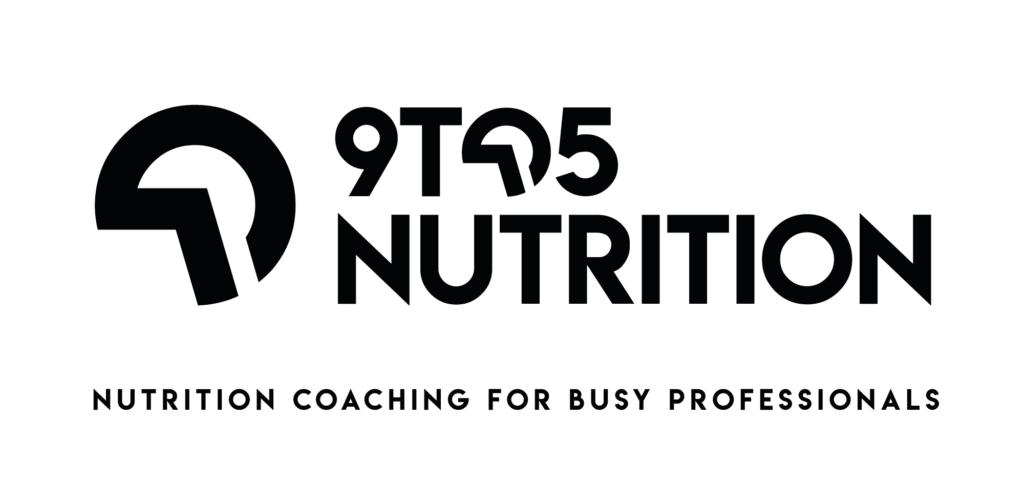
Leave a Reply